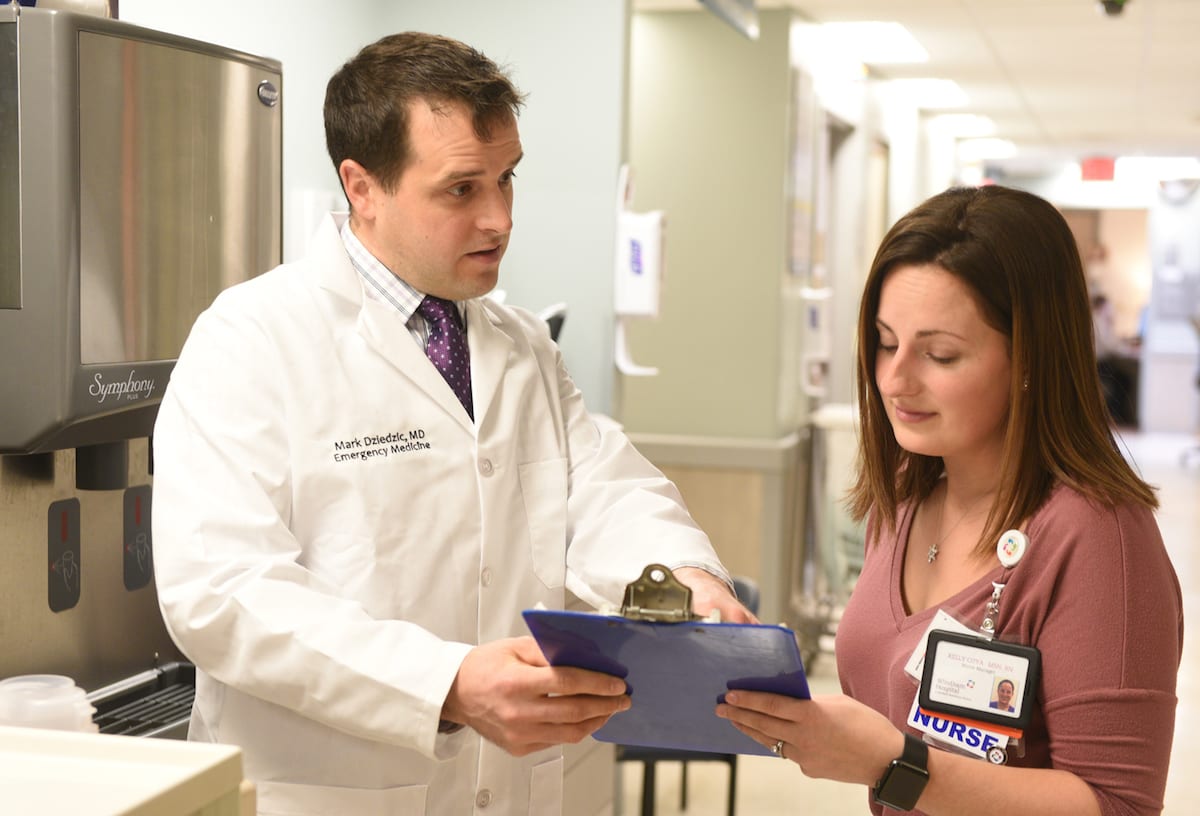<< Back
Finding Success in Opioid Treatment

January 07, 2019
On a recent weekday, a patient was brought into The Windham Hospital Emergency Department overdosing on opioids; doctors diagnosed him with Opioid Use Disorder and asked if he wanted to start recovery.
When he agreed, he was given a dose of Suboxone, a medication that eases what can be painful withdrawal symptoms and stops cravings for the drug. He was then sent to Hartford HealthCare’s Medication Assisted Therapy Close to Home (MATCH) Program at Sachem House at Natchaug Hospital in Mansfield to work on his sobriety in an outpatient setting.
Providers at Windham and Backus hospitals’ Emergency Departments, along with other system EDs, can now administer Suboxone for willing patients who want to begin on the road to recovery.
“Being able to initiate Suboxone in the emergency department allows us to take advantage of a crucial moment in that patient’s path of drug abuse,” said Mark Dziedzic, MD, medical director of the Windham Hospital Emergency Department. “When a patient comes to us seeking detox and is in active withdrawal, we can treat their symptoms completely with Suboxone.
In the past, we only
gave symptomatic
treatment which is
not very effective.” Kyle McClaine,
MD, medical director of the Backus
Emergency Department, said being
able to administer
Suboxone is a crucial tool on the road to recovery.
“Medication assisted therapy in the follow up/outpatient arena is the most successful opiate use disorder treatment currently available,” said McClaine. “Induction with Suboxone in the ED for appropriate patients is
a key start to the process. HHC has taken great strides to increase the availability and referral mechanism to these programs, and they are the true key to reducing opiate deaths.”
J. Craig Allen, MD, is medical director at Rushford and co-chair of the Hartford HealthCare Opioid Management Council, which recently identified a need for providers to administer Suboxone in system emergency departments across the state.
The move, he said, was prompted by a state Medical Examiner’s Officer report that there were more than 1,000 opioid-related overdose deaths in Connecticut in 2017.
“We saw this as a huge opportunity,” Dr. Allen said. “Research supports identification and intervention as a path to decreasing opioid overdose deaths. Screening for misuse and providing harm reduction education, naloxone prescriptions (the opioid overdose reversal medication) and referrals for medication-assisted treatment are considered ‘best practice’ to beat this crisis and improve public health.”
He added, “Optimal treatment is starting buprenorphine medication such as Suboxone as soon as possible with patients in the emergency department. This shows improved engagement and patients are more likely to remain in outpatient treatment 30 and even 60 days after discharge.” Dziedzic agreed.
“Patients in active withdrawal are uncomfortable and could be more likely to use again even if they want to quit. By initiating Suboxone, we can bridge them for the time it will take for them to get to the medication-assisted treatment program as opposed to having them suffer,” said Dziedzic.
In order to start Suboxone in the ED, there has to be an outpatient clinic the patient can go to receive therapy and continue their prescription. Without the medication, which is called opioid replacement therapy, the patient will experience withdrawal symptoms and cravings leading to a high risk of relapse. In the past, the lack of outpatient programs has been a barrier to inpatient or ED induction of Suboxone. However, at Hartford HealthCare, the Behavioral Health Network (BHN) has developed 11 (soon to be 12) locations (Avon, Backus Hospital, Charlotte Hungerford Hospital, Cheshire, Dayville, Glastonbury, Groton, The Hospital of Central Connecticut, Mansfield, Meriden and Middletown).
“Our goal is to create a seamless system to help people with opioid use disorder receive first-line, evidence-based care regardless what Hartford HealthCare ‘door’ they enter. The emergency departments are our initial focus given the large number of high-risk patients, but soon we’ll be treating opioid use disorder in all our acute care hospital settings and primary care clinics,” Dr. Allen explained.
A three-day, broadly focused quality improvement project called
a “Kaizen” was held last summer, bringing all BHN programs offering medication-assisted treatment for opioid use disorder into alignment. The workgroup established five areas or “pillars” they felt were essential for substance use disorder treatment. All programs working toward meeting these goals will be considered Medication Assisted Treatment Close to Home (MATCH) clinics. The goals are:
- Foster shared understanding and education. All staff, clients and involved family members receive standardized education on substance use disorder and its treatment.
- Create a single point of contact for all MATCH programs. Regardless of a person’s location, one phone call will connect them to the closest MATCH clinic or other community treatment resource.
- Establish same-day access to clinicians and Suboxone prescribers.
- Create financial transparency so there is a clear understanding of insurance coverage and the client’s financial responsibility.
- Expand recovery capital by placing a priority on engaging the family and community support services in the treatment and recovery process.
“The expansion of our medication provider network now allows us to treat more people with first-line, evidence-based, FDA-approved medications because we can safely transition them to outpatient MATCH settings,” Dr. Allen said.
For more information, visit HartfordHealthCare.org/MATCH or call 1.855.825.4026.